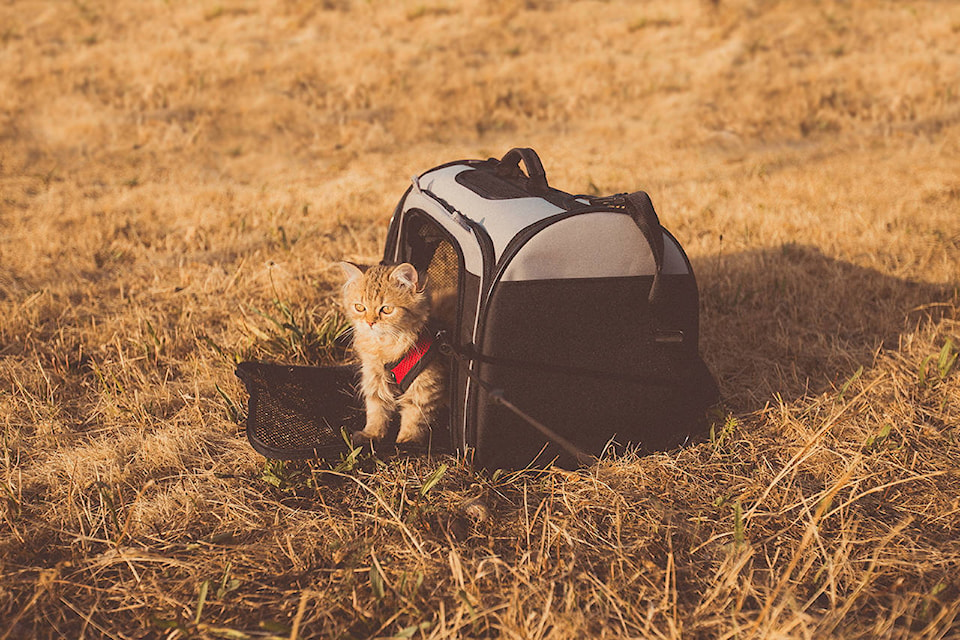By Nicolette Joosting
After a winter filled with major storms, massive power outages and periods of extreme cold, we now facing our wildfire season in B.C.
With Emergency Preparedness Week happening from May 5 to 11, and Animal Disaster Preparedness Day on May 12, this is a good time to think about how you and your family will cope in one of these events. Civil emergency services can be quickly overwhelmed, and you should not be solely reliant on their help. Our pets are often neglected in the emergency response, which can cause added anxiety and distress in a disaster.
RELATED: Get prepared: 72 hours of emergency readiness
This article will take you step by step on how to include your pets in the preparedness planning, from knowing what emergencies could come up in your community to how you should pack for an evacuation.
Think about what disasters are possible in your area
Is your home in a flood zone? Or is a landslide more likely?
In order to begin to prepare for an emergency, you need to know what could happen. One good way is to go through the potential disasters on Prepared B.C.’s website and find out which ones are possible in your community.
I found that it helps to write these down – from house fire to wildfire. Initially, it may seem overwhelming, but once you have the list, you can start thinking what is required for each event.
Check your insurance policies
This really helps for peace of mind.
The Insurance Bureau of Canada has a “Know Your Policy” campaign and helpful tips for Disaster Preparedness Week. Keep your insurance company policy number and contact numbers in your emergency kits.
Depending on the emergency, you may not be able to get out with your bag, phone or wallet, so consider leaving copies of important documents with trusted friends or family who don’t live in the same area.
Discuss and prepare your emergency plan
Many websites offer online planning tools for emergencies — I do the Canadian government’s “Make an emergency plan” online. Fill one out for your family, which should identify evacuation routes, meeting places, and emergency contact information. To this, I add the pets:
- Make a list of which hotels and motels along your evacuation route will accept you with your pets in an emergency.
- Prepare a list with phone numbers of any friends, relatives, boarding facilities, animal shelters or veterinary facilities that are available to care for your pets in an emergency – add these to your cell phone contacts.
- Include your pets in evacuation drills, using positive conditioning techniques. (Make sure each pet has its own carrier.)
- Keep vaccinations and parasite controls for your pets current. To reduce the spread of disease, shelters may insist on vaccinations.
- Make sure your pet has identification – a microchip that is registered with a central registry such as the BC Pet Registry as well as collars and coats identified with their name and your current contact details.
Prepare your emergency kits.
After going through the previous steps, you will have a fair idea of what you will need in your grab-and-go bags. I found it helpful to prepare for three different events: trapped at home (7-10 days), evacuation (72 hours) and a vehicle kit for a roadside or travel emergency.
You can make up your own kits, buy prepared kits or do a combination of the two. There are many online suppliers; one of my favorites is the Canadian Red Cross.
You can adapt the kits to you and your pet’s needs, find multi-use items that aren’t heavy or bulky, or use renewable resources and avoid plastics.
Your pets should have their kits in separate totes and bags. You may be separated from your pets during emergency situations; pets, except service animals, are evacuated and sheltered in different locations to their humans.
Examples of what I have in my pet evacuation kit include:
- enough water to meet daily needs for 72 hours;
- collapsible water bowls;
- enough food to meet daily needs for 72 hours, including treats, cans and dry food (be aware of expiry dates);
- camping, collapsible or compostable food dishes;
- a manual can opener;
- paper towels;
- garbage bags;
- blankets and bedding;
- a carry crate for each pet (collapsible for larger pets);
- a tent or collapsible shelter;
- doggy bags or disposable cat litter tray;
- prescription medications;
- pet brushes;
- comfort toy;
- spare harness and leads;
- high visibility coats and collars with identification and owner details;
- first aid kit;
- summary of medical records;
- and information on feeding schedules, behaviour problems, medical conditions and the contact information for your information to hand over to a foster or shelter.
Make sure you label and identify each kit clearly, including name and contact details.
Prevention is better than cure
Emergencies happen, but you can do your part to prevent the worst of it.
In wildfire season, make sure your home is FireSmart by cleaning up brush from your yard, getting fire resistant roofing, having fire-rated doors and enclosing the area under decks with fire-resistant materials.
When it comes to flooding, you can also store your valuable documents on the top floor, seal cracks in the foundation, install back flow valves on basement floor drains and even raise the electrical outlets on the first floor.
If you would like more lists of what to put in pet kits or a pet first aid kit, you can email me at catvet007@gmail.com. Happy planning and preparedness!
Nicolette Joosting is a Harrison Hot Springs resident and veterinarian who has recently retired from her Vancouver Feline practice. She keeps herself busy through the Harrison Veterinary Service, her blog and by volunteering in the community.
news@ahobserver.com
Like us on Facebook and follow us on Twitter
